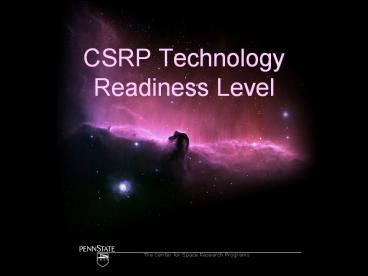CSRP Technology Readiness Level - PowerPoint PPT Presentation
Title:
CSRP Technology Readiness Level
Description:
TRL Definitions: DOD Interim Guidance. Basic principles observed and reported. Level 1 ... Examples include integration of 'ad hoc' hardware in the laboratory. Level4 ... – PowerPoint PPT presentation
Number of Views:84
Avg rating:3.0/5.0
Title: CSRP Technology Readiness Level
1
CSRP Technology Readiness Level
2
TRL Definitions DOD Interim Guidance
DoD definitions are closely derived from NASA
(Mankins 95) (NASA terms are in parentheses)
Level 1 Basic principles observed and reported
Level 2 Technology concept and/or application formulated
Level 3 Analytical and experimental critical function and/or characteristic proof of concept
Level 4 Component and/or breadboard validation in laboratory environment
Level 5 Component and/or breadboard validation in relevant environment
Level 6 System/subsystem model or prototype demonstration in a relevant environment (Ground or Space)
Level 7 System prototype demonstration in an operational (space) environment
Level 8 Actual system completed and (flight) qualified through test and demonstration (Ground and Space)
Level 9 Actual system (flight) proven through successful mission operations
3
TRL Descriptions Hardware Software
Level1 Lowest level of technology readiness. Research begins to be translated into applied research and development. Examples might include paper studies of a technology's basic properties.
Level2 Invention begins. Once basic principles are observed, practical applications can be invented. Applications are speculative and there may be no proof or detailed analysis to support the assumptions. Examples are limited to analytic studies.
Level3 Active research and development is initiated. This includes analytical studies and laboratory studies to physically validate analytical predictions of separate elements of the technology. Examples include components that are not yet integrated or representative.
Level4 Basic technological components are integrated to establish that they will work together. This is relatively "low fidelity" compared to the eventual system. Examples include integration of "ad hoc" hardware in the laboratory.
Level5 Fidelity of breadboard technology increases significantly. The basic technological components are integrated with reasonably realistic supporting elements so it can be tested in a simulated environment. Examples include "high fidelity" laboratory integration of components.
Level6 Representative model or prototype system, which is well beyond that of TRL5, is tested in a relevant environment. Represents a major step up in a technology's demonstrated readiness. Examples include testing a prototype in a high fidelity laboratory environment or in simulated operational environment.
Level7 Prototype near or at planned operational system. Represents a major step up from TRL6, requiring demonstration of an actual system prototype in an operational environment, such as in aircraft, vehicle, or space. Examples include testing the prototype in a test bed aircraft.
Level8 Technology proven to work in its final form and under expected conditions. In most cases, this TRL represents the end of true system development. Examples include developmental test and evaluation of the system in its intended weapon system to determine if it meets specifications.
Level9 Actual application of the technology in its final form and under mission conditions, such as those encountered in operational test and evaluation. Examples include using the system under operational mission conditions.































